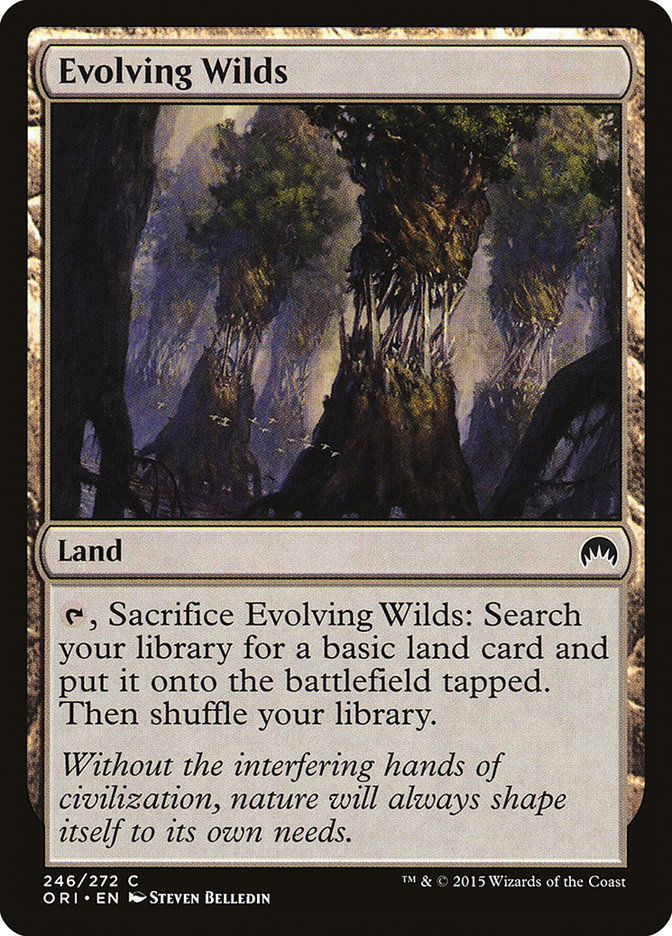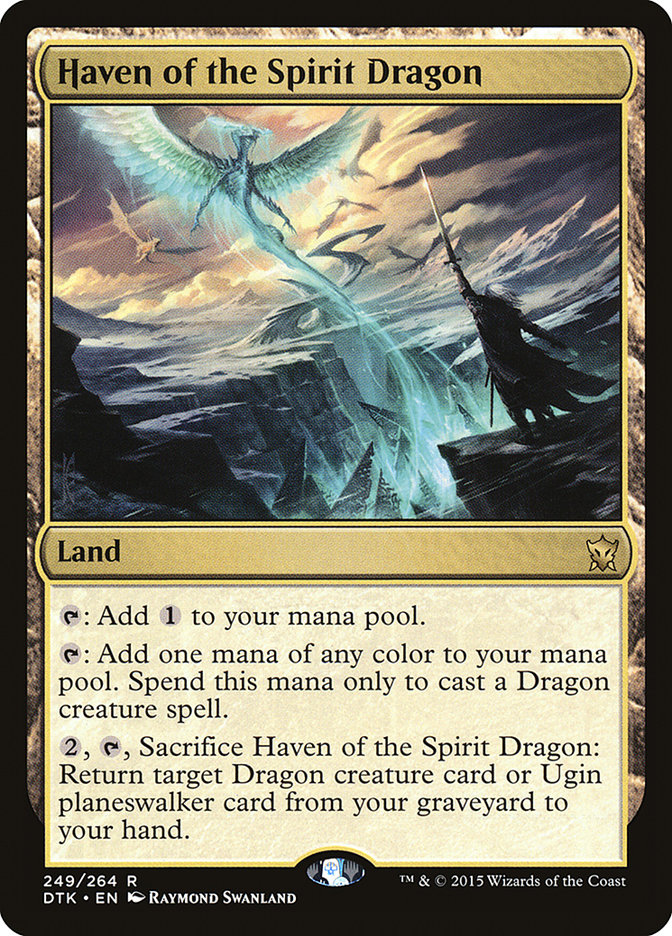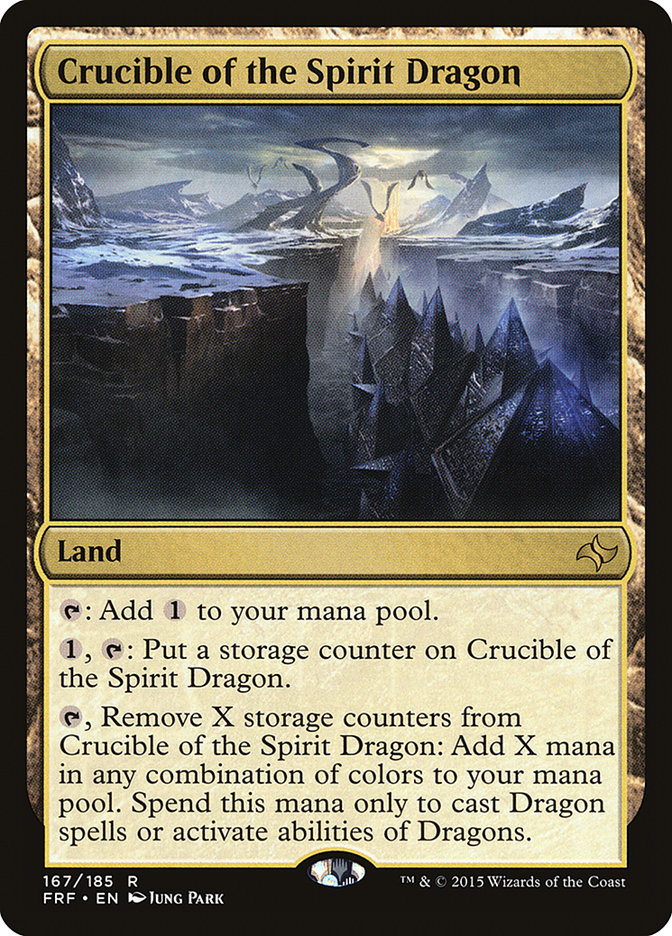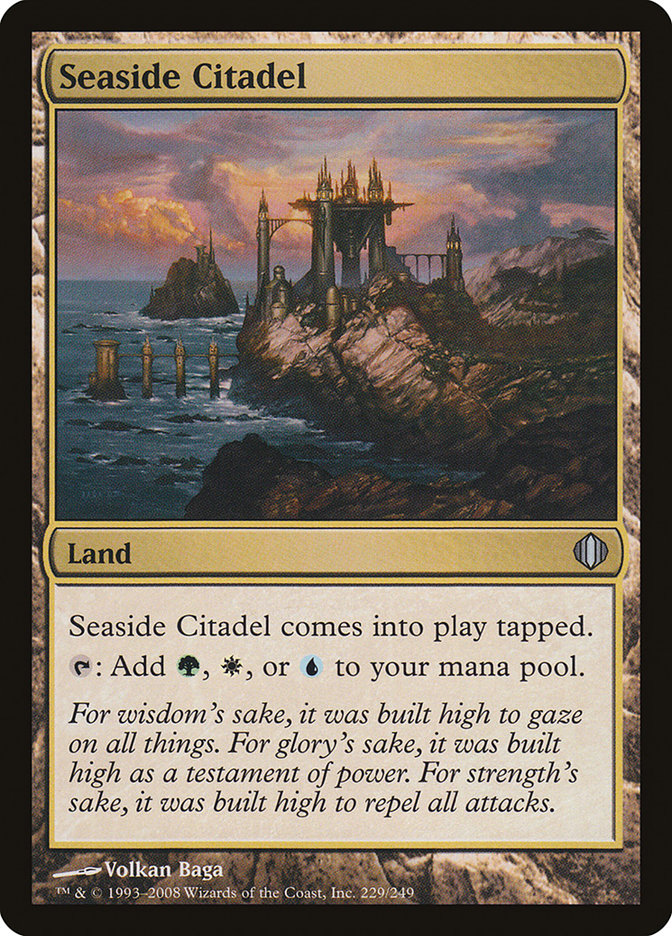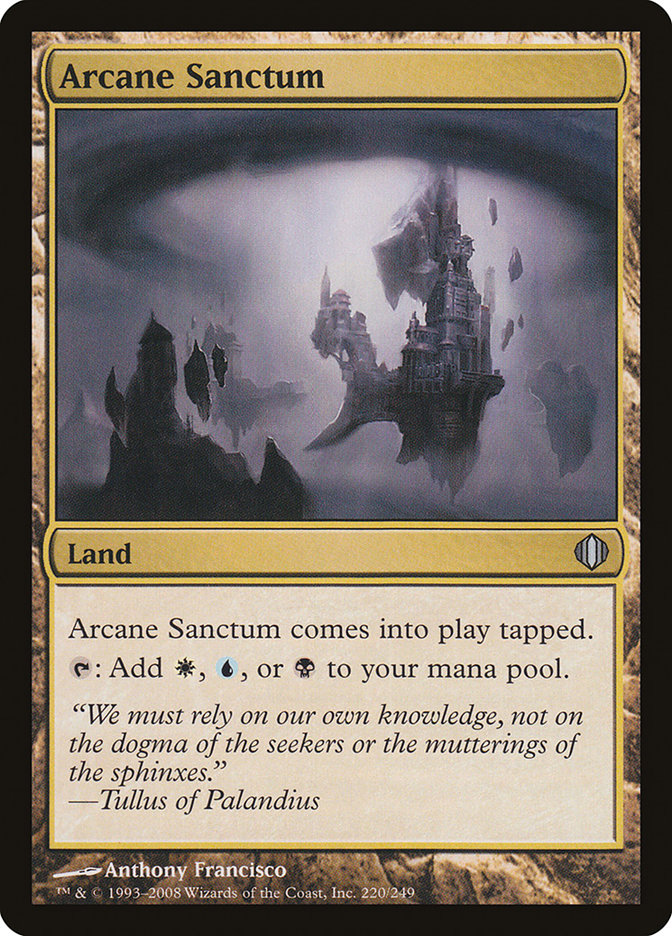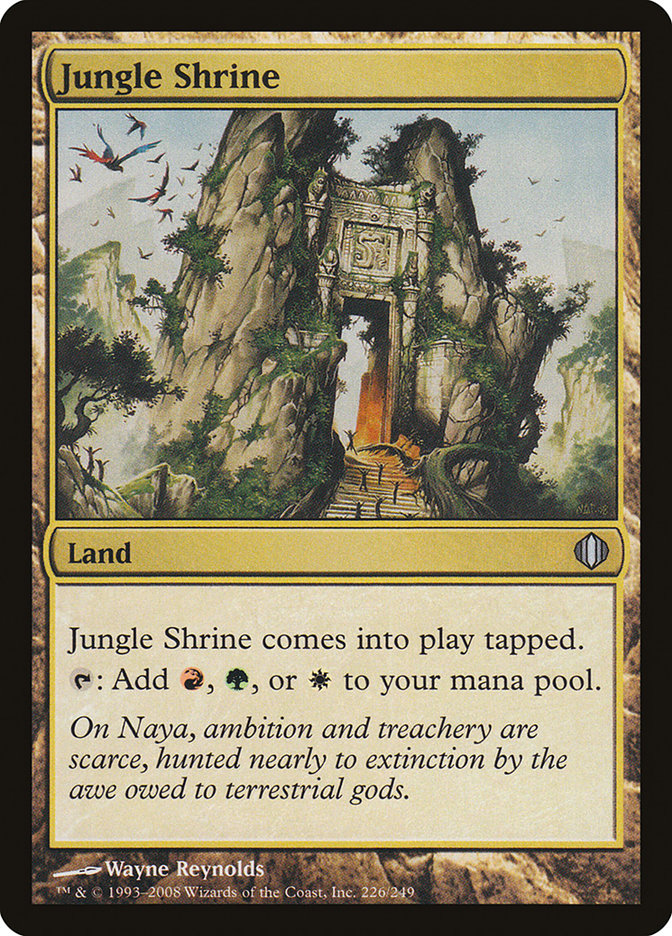Standard has waxed to its largest point thanks to Magic Origins, and with the change to an eighteen-month format cycle rather than a two-year cycle it is reasonable to predict that it shall never again have quite so many cards in it, barring Time Spiral 2: Electric Boogaloo having the biggest “Timeshifted” sheet imaginable. Soon it will wane to its smallest point, but thanks to the powerful mana fixing of Khans of Tarkir Block that will not present the problem we usually encounter at that time – we’re used to small Standard card pools having little in the way of fixing, but even without the Temples from Theros Block we are actually in one of the best eras of solid mana Standard has ever encountered.
Such is our riches that we do not even use them all and are hardly aware of their presence; we don’t know just how much we can get away with if we try. We see it sometimes in the various colors of Dragons decks – be it Mike Flores Mono-Blue 5c Dragons deck or Kent Ketter G/B build of the same. You could arguably pair a large number of Dragonlords with any single color or any two-color combination if you wanted to and reap the benefits accordingly – if your problem is early aggression, then red’s control cards would be a good pairing for the top-end Dragons, and the only thing keeping the G/R Dragons deck from playing Dragonlord Ojutai is “them wanting to.”
We are thus at least cognizant of how much we can get away with if we try – Silumgar’s Scorn plus Dragonlord Atarka is a known quantity, if something of an oddball one at the moment. But we are about to return to Zendikar with who-knows-what cycle of dual lands to complement what we already have today, so examining what is possible if we try will give us a good idea of what the future may hold in addition to exploring what we can do today if we embrace a greedy manabase rather than a simple one.
The primary benefit for keeping your colors limited is access to the Theros Block Temples, because Temples are a powerful thing – who knew that simply adding a second color of mana to New Benalia would make it a format all-star? As good as that effect is, and it has been demonstrated to be quite awesome, you can make up for the Temples’ smoothing power by increasing your card power instead if you want to. Stretching to fit that fourth color may sound difficult, but it can reap bigger benefits than those offered by the Temples if it is done for the right reason. The gold cards we have access to in Standard are quite potent, and questions like “would Crackling Doom be good in my Mantis Rider deck?” are worth asking because that is an entirely-plausible thing that you could do.
Let’s begin by asking the generic question of “how,” because it’s not specific to any color combination – it is inherent to the structure of nonbasic lands available to us across different sets, and thus it follows a repeating pattern that we can readily observe.
A Lesson In Managing Greed
“Mana is usually the first thing I look for when I examine a new set or a new format. Many players try to figure out what cards they want to cast and then seek the mana to cast them, but I find it better to figure out first what mana is available.”
– Zvi Mowshowitz
Combining Khans of Tarkir, Fate Reforged, Dragons of Tarkir, and Magic Origins, we have access to the following cycles of mana fixers:
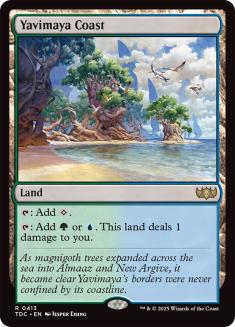
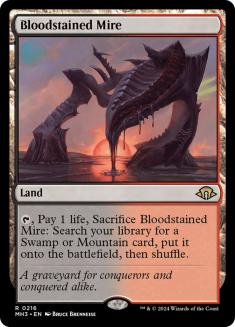
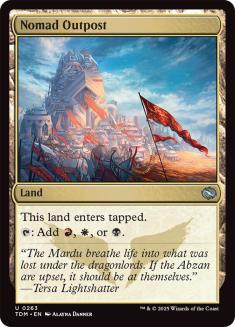
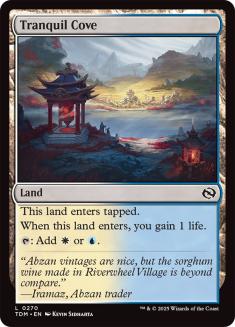
Five enemy-colored painlands, five ally-colored fetchlands, five enemy wedge tri-lands and all ten two-color “gainlands” give us a lot of fixing to work with even without the ubiquitous Temples of Theros Block – and that is a wealth of good mana fixing even without knowing what lands we will see in Battle for Zendikar. Theros Block doesn’t actually improve our access to colored mana, merely our benefits for seeking it – Temples are incredibly strong, and thus they have tended to be dominant during deckbuilding, but we could play pretty much the same decks with gainlands instead and cast all of the same things. It wouldn’t be as good, but we could have lived in that universe if, for example, a developer had decided that the Temples were too good for Standard. But wait, there’s more:
Theros Block also offers us Mana Confluence, which is both powerful and fairly unique – we don’t usually get five-color lands this good, and having access to a land that is better than the eminently-playable City of Brass is rare indeed for a Standard format. We won’t get to keep it come October, but if we wanted to use it now, we certainly could… though probably only in small numbers. We also have not just one but two lands that are better than City of Brass by a country mile if the multicolored cards we are interested in casting just happen to be Dragons, and given the power level of most of the Dragonlords that’s not a bad payoff to want. And potentially supplementing our powerful fetchlands is their humble common cousin, Evolving Wilds, which has frequently been in Standard but also frequently not been good enough. Lately it has only seen play in decks that really want to cast Chained to the Rocks, but from time to time it’s filled a useful role in small quantities and is worth remembering at the margins.
We can play two-color decks very easily – we get a gainland for sure and either a fetchland or a painland in our colors, and if we need more fixing than that, well, at least one of the Khans tri-lands will also have our two colors of mana on them no matter what color combination we’re playing. Our tolerance for enters-the-battlefield-tapped lands dictates our options, and unless we’re in the market for Mana Confluence all we really get as an upgrade right now from Theros mana is that we start with four Temples before moving on to other tapped lands and the next-best set still gives us a benefit, even if it’s just one life. Half of the two-color decks would prefer their fetchland or painland to their gainland, but sometimes a stray Rugged Highlands or two does show up. For everyone else, the mana is just too good to want more tapped lands, and they don’t tend to touch Mana Confluence until they’re full-on tri-color decks. Even then it’s more likely for an aggressive player than a controlling one – Abzan Aggro has Mana Confluences but Abzan Control usually does not, favoring a few more Temples instead.
But we were talking about greed. How far can you go if you try? What do the mana structures allow once we push out of the comfort zone we’re used to seeing in this Standard world of two-color decks (both allied- and enemy-colored) and tri-color decks (usually but not always based around one of the five Khans wedges)?
Four-color decks require structure and discipline to build right. You can’t just play all four colors in equal proportion because that would require you to play a manabase with no bias to it in favor of major and minor colors – picking one or two colors as the core of your deck and then splashing the other two will tend to be far more successful, as you’ll always be able to cast your major colors’ spells and will only potentially have to wait for your splashed cards, and you might not even draw those in the games when you can’t find that color of mana anyway. In three-color land we saw no real clear reason for bias in our manabases – you either got a tapped tri-land for picking an enemy wedge or access to two fully on-color fetchlands for picking an allied shard, and the reason for picking a wedge over a shard has largely come down to the power of the Kahns of Tarkir gold cards rather than the power of the lands themselves.
But four colors… four colors runs head-on into the structure of mana in this format, which favors that your two primary colors be an enemy-color pair and your two splash colors be the two colors that fill out that color pair’s enemy wedge. Black and white as your main colors wants to avoid its shard, Esper, and form two wedges – there are benefits to refusing to play with blue and pairing up with green and red instead. And not just for the gold cards: the lands themselves prefer it. Any two-color enemy combination gets to play with two Khans of Tarkir tri-lands (in this case Sandsteppe Citadel and Nomad Outpost) as well as their enemy painlands (here, Caves of Koilos) and each half of the main color pairing shares a fetchland with exactly one of the minor splash colors completing the wedge. (For white and black that’s Windswept Heath and Bloodstained Mire – because we’re skipping blue, Polluted Delta and Flooded Strand are right out.) You even get access to a third fetchland if you want it – but that only powers the splash colors, so if you do elect to play it, it will likely not be in great numbers. (For W/B splashing red and green that would be Wooded Foothills.)
The funny thing about Khans of Tarkir having allied rather than enemy-colored fetchlands is that the allied fetchlands are contextually weaker in this set – usually the allied land is the more powerful one because allied color pairs are usually better supported, but in this case each allied fetchland can only be associated with one Khans of Tarkir wedge while any enemy fetchland would have been associated with two. Mana infrastructures can be a weird inside joke sometimes, if you look deep enough for the punchline.
Our basic sketch of a manabase will start like this:
4 of Wedge #1’s Tri-Land
4 of Wedge #2’s Tri-Land
3 of Wedge #1’s Fetchland
3 of Wedge #2’s Fetchland
3 each of the two primary colors’ basic lands
2 of the primary colors’ enemy painland
1 each of the two splash colors’ basic lands
This gives us twenty-four lands and provides sixteen colored mana in both of our two primary colors and eight colored mana in each of our two splash colors. Sixteen colored sources is effectively the minimum we’d want in Standard for a primary color, as we occasionally saw in last year’s Standard format where mono-colored Devotion decks had to decide how many colored sources to play when they had access to both Mutavault and Nykthos, Shrine to Nyx. Eight colored mana in our splash colors may not actually be enough – we might want to tend towards ten instead, if we really want to draw them – but we’ll leave fine-tuning like that up to the specifics of each deck. We can draw a visual diagram that explains how our lands generically interact without actually needing to assign colors to them yet, and it would look like this:
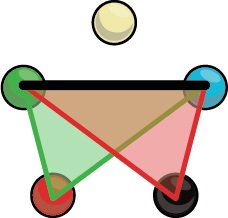
All you would need to do to understand how the mana interacts is rotate the color wheel you see on the back of every Magic card – starting with how it looks on the back of the card, white would be the excluded color on top and green/blue would be the enemy-color pairing that is shared across two Khans taplands and our enemy-color painland. Each of our splashes are connected as well by a fetchland that touches one of our primary colors, which in this case would be Polluted Delta and Wooded Foothills as fetchlands and tri-lands combine to tie Sultai together with Temur. It doesn’t matter whether you rotate the color wheel clockwise or counter-clockwise, so long as you keep the order of the five colors intact we’ll just be shifting which two Khans wedges we’re combining in the deck. That’s the hard question of “how,” but the deeper question is probably “Why?” Is there enough payoff for jumping through these hoops and giving up the Temples in our greed?
Our First Example – Abzan + Sultai
I could start with that color grouping for our example, but as far as my own exploration of the joys of greed are concerned that narrative starts with the idea that first drew me towards figuring out how this mana puzzle worked – I first asked “just how greedy can we get if we try?” about six months ago when Treasure Cruise had so fully blown up both Legacy and Modern that it had to get itself banned. Here was a card that had wreaked havoc on two very powerful formats… but in Standard we were barely playing it at all. Sure, we didn’t seem to have the cards like Thought Scour or Brainstorm that optimized it in the older formats, but we had some good ones if we wanted to try. Let’s begin not with black-white but with black-green, which splashes into Abzan and Sultai, to see what I’d come up with:
Creatures (24)
- 1 Hornet Queen
- 4 Sylvan Caryatid
- 4 Satyr Wayfinder
- 1 Soul of Innistrad
- 4 Siege Rhino
- 2 Tasigur, the Golden Fang
- 4 Den Protector
- 4 Deathmist Raptor
Lands (24)
Spells (12)

We deviate slightly from the mana formula here by shaving a Swamp and a Llanowar Wastes in favor of an Evolving Wilds and a Mana Confluence; this deck could afford the ninth tapped land, and while it probably didn’t need yet another colored source for the two splash colors thanks to the green mana fixers, the loss of tapping for pain-free colorless on a one-of land seemed like a low price to pay while we’re allowed to play Mana Confluence. It wasn’t required, but the price to “upgrade” to the soon-to-rotate five-color land was so very low for the first copy. I also wanted another fetchland to fuel my Treasure Cruises with, but neither the fourth copy of either of these nor the first Flooded Strand made sense, so Evolving Wilds it is.
Months and months ago, Sidisi, Brood Tyrant was making a dent in Standard and asking some interesting questions, and I liked where that deck was going but didn’t necessarily think it was shooting for the right payoffs. One-mana Murderous Cuts were built as the deck’s reward for filling up your graveyard so hard, as were a plethora of 2/2 Zombies, and while those were good when things worked out they were not actually that special when compared to, say, Treasure Cruise. Despite the fact that she could be very high-functioning and generate multiple tokens a turn, I actually didn’t really like Sidisi in that shell – she would usually just die to a Lightning Strike and your entire turn would be wasted with nothing to show for it. So I asked “What if we could play Siege Rhino instead, would that be worthwhile?”
Note I didn’t ask myself if that would be possible; I started with the greedier question and asked whether it would be good. And who doesn’t like the idea of getting to play multi-format all-stars like Siege Rhino and Treasure Cruise in the same deck? Then they went and printed Den Protector and Deathmist Raptor and the whole Megamorph shell could fit into the deck too, making the payoffs for self-milling so much higher and adding to the stream of card-advantage effects the deck had at the same time.
We could go even further now with Magic Origins and upgrade our Commune with the Gods for Gather the Pack instead, but we don’t really need to get a two-for-one off of it. We’re already going to be card-rich all of the time, and we’d only likely hit Spell Mastery off of the second copy of this three-of anyway. There was already some tension with Delving because Whip and our morph cards want us to keep creatures in the graveyard, and adding in Spell Mastery on top of that and potentially asking us to also preferentially keep our spells in the graveyard too is just not worth it. We’re already going to be impossibly rich in the card count, so I actually prefer the minor added utility of finding Whips of Erebos to the ability to get a two-for-one in this slot as the Whip is just incredibly valuable when it’s the right card for the job. Trying to decide how best to ration two different resources without knowing the “right” answer because we can’t see the top four or five cards of our deck meant that I was usually guessing wrong, and the Soul of Innistrad is there alongside the Megamorph engine to pay us off for all that self-milling anyway so we really don’t need to optimize for Spell Mastery here. Just because we got an “upgrade” in Magic Origins doesn’t mean it was worth the added tension that came with it.
This deck is so card-rich that really it just needs to focus on buying time instead of trading cardboard, which is why you’ll find a plethora of Drown in Sorrows alongside more Cuts and even another Tasigur to just get something big on the board fast against aggressive decks. Prior versions had dug so deep as to play Dead Drop in order to get around Heroic’s protection spells, but that was before Deathmist Raptor – now we can usually default to them needing to act first in order to beat us, so we’re responding to their protection spells with removal rather than the other way around. The real enemy turns out to be beatdown decks because we don’t have the luxury of time required to overpower them with Treasure Cruise, but Drowns + Tasigurs + Cuts and digging for an extra Whip of Erebos after sideboarding just for the Lifelink side is a strong way to answer them and put the game out of reach on the life side rather than the card side like we usually aim to do.
While this is the deck that remains nearest and dearest to my heart for showing off purely greedy purposes – Treasure Cruise is a great payoff card that way – it’s time to keep moving on and asking more questions.
Jeskai + Mardu
Because this deck was an aggressive build it didn’t really want to have to afford the extra land coming into play tapped, but it needed to in order to hit its colors right in the early game – and worse yet, it actively wanted more sources of its other colors but had no cheap card draw or green fixers to help it out. So again we shaved the third basic of its second color (white, here, because our only double-colored-mana spells cost red) in favor of an Evolving Wilds and upgraded our Battlefield Forges to Mana Confluences while we still can. The deck has enough cheap lifegain creatures that it can offset the real costs, but as an aggressive deck without access to any of that sweet, sweet green fixing or any cheap cantrips like we’re used to seeing in other formats, we actively need the Confluences in order to hit our tri-color threes and fours on time.
Creatures (20)
- 1 Hushwing Gryff
- 4 Goblin Rabblemaster
- 2 Zurgo Helmsmasher
- 4 Mantis Rider
- 3 Butcher of the Horde
- 4 Seeker of the Way
- 2 Soulfire Grand Master
Planeswalkers (1)
Lands (24)
Spells (15)

The idea here was pretty simple: I liked the aggressive side of the Jeskai decks but wanted them to be a bit burn-heavier and was running into tempo problems. I wasn’t able to get under my opponents the way Mono-Red Aggro does, so the burn spells weren’t playing the same role. I wanted to take out creatures and deal damage, but Searing Blood’s moment in the sun seems to have come and gone – it just wasn’t performing anymore. So, greed answered instead: what if instead of using a burn spell to kill their blocker and attack in for a bit we used Crackling Doom to kill their best creature instead and got our chip shot in that way? Looking a bit harder for that type of effect, Self-Inflicted Wound suggested itself as a powerful sideboard card against a deck like Heroic since it bypasses their vital protective spells while also getting that bit of damage in, and if B/R Dragons is a thing again in this metagame then Butcher of the Horde is probably pretty bonkers too.
The problem wasn’t the midrange matchups – we could fly over green decks and even use burn spells to push through Goblin Rabblemaster – the problem was the more aggressive matchups where again Treasure Cruise wasn’t cutting it and some of our main-deck fun-ofs like Hushwing Gryff weren’t pulling their weight. Thus the sideboard favors cheaper interaction and ways to help drop the curve, and remembering that Self-Inflicted Wound suggested to me that another Dragons of Tarkir hoser might be just what we wanted to salve our aggro matchups. Before reaching for Arashin Cleric in my aggro-tempo deck, I realized Surge of Righteousness might be perfect instead – take out the most problematic creature they’ve got and gain a bit of life while we’re at it! Surge can fill the traditional role of a Lightning Helix analogue against other red decks, and thus was far better than a random 1/3. Add a light spattering of countermagic, another Cruise in the board for when we want it and completing the set of Exquisite Firecraft lets us take on control decks fairly well; we’re already in a favorable position there by being an aggressive tempo deck to begin with, and it helps that we’re going a bit bigger and a bit slower when it comes to avoiding the sorts of answer cards control decks would normally point at aggro opponents.
But if we wanted to just focus on getting in chip shots of damage, that’s another pairing entirely…
Abzan + Mardu
The allure here is of course getting to combine Siege Rhino with Crackling Doom – the hard part with this much blank canvas to work with is figuring out which synergies are available and worth building around, and having both a potent threat and a potent removal spell conspiring to rob our opponent of a few life points while we’re at it was a strong argument for a greedy but aggressive shell in this color combination. It’s perhaps underwhelming, but you know Magic – it may not seem worthwhile right now, but maybe we’re just one printing away from the strong card that busts it right open. We’ll have the large bulk of this shell still available when we battle in Zendikar in a few months, and we’ll have far weaker opponents when we try it then as well as a bunch of new cards to consider.
Creatures (24)
- 3 Brimaz, King of Oreskos
- 2 Anafenza, the Foremost
- 4 Siege Rhino
- 2 Chief of the Scale
- 4 Chief of the Edge
- 1 Kolaghan, the Storm's Fury
- 4 Battle Brawler
- 2 Brutal Hordechief
- 2 Kytheon, Hero of Akros
Lands (24)
Spells (12)

A Warriors sub-theme seemed appropriate; we really wanted the best drops we could find at the two- and three-mana marks, and having multiple two-drops with three power or at least the potential to get three power seemed like a great way to build a better mana curve. We can expect to have our first turn spent on a tapped land, but after that we’re just going to drop threats and see what happens. While it’s not really a strong argument to say we should be playing this instead of Abzan Aggro with its Fleecemane Lions, soon we will not have that option but this tribal synergy will remain intact – and there are a few surprises that went with the incidental-damage theme, like the Hellrider-esque ability of Brutal Hordechief and “surprise!” Kolaghan, the Storm’s Fury coming out of nowhere once in a while to swing for lethal.
Again we went with Mana Confluences over the two-of painland that was in our default setting; we could survive without it, and in October we might just have to, by replacing it with an Evolving Wilds and a Wooded Foothills. While I would be hard-pressed to justify shuffling this up – I’m not sure the payoffs are all there – that might just mean I’ve picked the wrong incentive cards and the right ones are there waiting to be found. Build it as a control deck instead of an aggressive one and now we’re templating it off of Abzan Control rather than Abzan Aggro – suddenly we’re shooting for the top end rather than the bottom end (though probably adding two or even three more lands) and can plan to do absurd things like follow up Elspeth, Sun’s Champion with Dragonlord Atarka.
Which opens another rich vein of consideration… what if the splash color’s payoff cards we’re interested in are Dragons instead, how does that change our plans when we want to add Haven of the Spirit Dragon rather than our fourth color’s tri-land to complete the wedge?
Let’s not dive off into that greediest of tangents quite yet though, let’s see what else is possible and complete the two remaining missing decks.
Sultai + Temur
This was destined to be the hardest sell of the five, actually, for a simple structural reason – this pairs the two worst creature-control colors together as its primary colors and only gains access to removal spells via its splashes. Green can’t answer a creature without reaching for Perilous Vault or something like Setassan Tactics, and blue’s not doing all that much better – there is a reason Mike Flores‘ five-color Dragons deck had to rely on Encase in Ice as its maindeck removal spell of choice after adding in as many Perilous Vaults as seemed to fit the strategy, an Ugin for good measure, and whatever splashed-for removal might come his way via the many Dragonlords. Counterspells are powerful, but things that resolve and enter play are going to be something of a problem for a U/G deck, as this deck exemplifies.
Creatures (23)
- 4 Sylvan Caryatid
- 4 Satyr Wayfinder
- 4 Savage Knuckleblade
- 1 Tasigur, the Golden Fang
- 2 Dragonlord Atarka
- 4 Den Protector
- 4 Deathmist Raptor
Lands (24)
Spells (13)

Like the last deck, I have to start wondering if maybe the incentive cards I’m reaching for are just wrong. All twos and threes and then Tasigur + Dragonlord Atarka off the splash? This played a solid Megamorph game as in our first example, and the mana is nice and smooth because this is the other deck that gets to use green as its primary color, but the tradeoff here is that the removal is a stretch and all we really get for all that blue mana is the ability to justify a bit of countermagic and the ability to choose Dig through Time over Treasure Cruise if we want to. Our power splash cards for Sultai are what, Sultai Charm? Sidisi, Brood Tyrant definitely wasn’t better than Siege Rhino when last we went down this path, but here this deck is saying it’s not really good enough at all – it gives up that slot to Savage Knuckleblade instead, which makes me start thinking this wants to be a Collected Company deck, not a Gather the Pack deck, again because Spell Mastery when we’re managing Delve cards is probably a lesser payoff.
It’s entirely possible the correct answer is Gurmag Angler rather than Savage Knuckleblade, but once we’re going there we realize the incentives are just all screwed up again because the gold cards in these color combinations aren’t up to Siege Rhino’s snuff. Maybe this shell is supposed to be Megamorph + countermagic + Dragonlords and we should be cramming in Silumgar alongside that Atarka – in which case we’re back to square one where we started with Kent Ketter B/G Dragons deck but wanting to switch it to U/G instead, trading Foul-Tongue Invocation for Silumgar’s Scorn.
So many options, so many unanswered questions. This deck is more than one solid multicolored card away from being worthwhile, because it’s lacking in any clear direction that is worth all the work this manabase requires, but what seems like the bottom of the barrel so far may just be amazing once we get to Zendikar… or once someone decides to pursue better incentives in their quest for maximum greed.
Jeskai + Temur
Instead of mangling the incentives here, I realized I was asking the wrong questions. Blue and red are pretty spell-based colors, so I wanted this to play more like a Jeskai deck than a Temur one, and realizing that made me want to take the deck in a controlling direction immediately suggested that we have to shift the manabase by adding two more lands. Our first example kept hitting its land drops thanks to Satyr Wayfinder and Treasure Cruise, but this one will need to just draw more lands… so instead of our two enemy-color painlands we’ll add two Temples, and the two painlands of choice will be the other available enemy pairs – one Battlefield Forge and one Yavimaya Coast.
Creatures (17)
- 4 Savage Knuckleblade
- 2 Dragonlord Atarka
- 3 Dragonlord Ojutai
- 4 Jace, Vryn's Prodigy
- 4 Harbinger of the Tides
Lands (26)
Spells (17)

While half of our payoff here is Dragon cards, in both of these cases at least it’s clear to me that I am splashing actual colors for actual cards – I can see a use for Savage Knuckleblade here that wasn’t as apparent in the last build, and Ojutai’s Command is quite the Magic card in a deck with Jace and Harbinger of the Tides. This is trying to be the somewhat-bigger version of the controlling Jeskai Midrange decks, with its cheap removal and mix of pressure cards chosen specifically to be hard to answer via the removal spells we see used in today’s metagame like Dromoka’s Command or Ultimate Price. Cheap drops don’t fight Savage Knuckleblade very well, and the window for killing Jace with a removal spell only stays open for a few turns before he ascends to Planeswalker form. While this deck also feels like it wants something else to incentivize itself for going to this distance, when the Temples up and disappear that may be enough by itself to make this more worthwhile – those rewards for sticking to three colors disappearing may pressure us to search for new ways to get an advantage anyway.
While I wouldn’t want to shuffle this up for a PPTQ or an IQ tomorrow, I’d be comfortable shuffling it up for Friday Night Magic and learning more about it, and it again drags my thoughts in interesting places – what if we followed our line of thought from above and tried to see what happens when we structure our deck with Haven of the Spirit Dragon standing in for the missing Shards of Alara tri-lands in our incentive structure? We’ve explored Abzan + Sultai, but is that really different than Abzan + Jund? Enemy shards might meet up in interesting fashion with allied shards by channeling the spirit of Kent Ketter greed if the incentive cards were all Dragons, and that Ketter’s deck even exists in the first place tells us that there are way more two-color combinations of Dragons decks just waiting to be found if we want to go looking for them. Mike Flores thought he was being greedy when he added the four other colors of Dragons to his otherwise-monoblue deck, but what does greed look like when it’s sought out and aggressively pursued?
Four-Color Dragons
We aren’t going to explore all five of these, because we’re mostly interested in it as a proof of concept. Even some of the five decks above were more to show what you can do than to show that it’s worth doing, and that’s ultimately what this experiment is about – finding the boundaries and seeing if they are worth exploring rather than returning with polished decklists and a promise of FNM glory to the savvy reader. We can brew harder and farther than we’ve tried if we only wanted to, so let’s ask another question – I liked Siege Rhino + Treasure Cruise, but what does Siege Rhino + Dragonlord Atarka look like? Think of it as a search for the nut-high trump to replace our now not-quite-good-enough Elspeth, Sun’s Champions out of the Abzan deck (depending on which week of the metagame cycle you find yourself in).
How big can we go? How greedy can we get? It stands to reason that we can play a two-color base in our five-color Dragons deck because Kent Ketter did so successfully – or at least it stands to reason that there should be four such viable potential shells, assuming that the green fixing is a critical part of the shell rather than assuming all ten combinations are naturally going to be equally viable. It stands to reason we can go pretty far – but can we go farther?
Creatures (25)
- 4 Sylvan Caryatid
- 4 Satyr Wayfinder
- 4 Siege Rhino
- 2 Dragonlord Atarka
- 3 Dragonlord Dromoka
- 4 Den Protector
- 4 Deathmist Raptor
Lands (26)
Spells (9)

You’ll note many of the same features – a black and green base reinforced by our Khans tri-land, the same mix of two fetchlands as we had seen in the Abzan + Mardu deck above. But since most of the splash cards are Dragons rather than other spells of those colors, we can stay largely a G/B shell – and that means we’re reinforcing our mana with Temple of Malady and Llanowar Wastes. But where the Abzan + Mardu deck was trying to beat down and stretching a little to justify the extra work put into its greediness, here the incentives are major payoffs: Dragonlord Atarka is a pretty nut-high trump, after all, and the added synergy between Haven of the Spirit Dragon and Satry Wayfinder is a stealthy but quite powerful payoff as well, a key part of what made Ketter’s deck worthwhile when it crashed into our consciousness in the first place.
As to the question of “why,” that was answered pretty neatly for me by taking it into tournament play. While it fills many of the same roles of a traditional midrange Abzan Megamorph deck, instead of petering out at the top of its curve it now gets to call on its Dragon cards for a power advantage – and that Wayfinder/Haven interaction means we are quite likely to have found a Dragon worth casting on time even if we haven’t naturally drawn one. It’s actually just Ketter’s deck with Siege Rhino over Ojutai, and Siege Rhino is quite a card these days while Ojutai hasn’t really been on anyone’s radar in a while. More than one blue mage has gotten unexpectedly pouty and then quite expectedly dead when my six-drop was Dromoka rather than Elspeth, Sun’s Champion, and mid-game copies of Dragonlord Atarka that take out chunks of their board would often run into that last piece of saved removal from our opponent trying to get back towards parity only to see that removal spell trade for our land instead and the Dragonlord’s return took out even more threats on their side of the board. This one does tempt me, and I found it quite nice at low-level play if still in need of tuning – I think it’s a land heavy at this point and the sideboard seems a bit off now that we live in Hangarback Walker’s world as thoroughly as Grand Prix London’s Top Eight suggests. But the point was in asking the interesting question, and the benefits seemed to be there at the top end rather than finding the deck somewhat conflicted as several of our proof-of-concept decks above were.
We have many more rich veins to explore as we prepare for the battle in Zendikar – the last time I remember having mana quite this good as we shifted towards a small Standard format, people started doing stuff like this as soon as the format rotated and everything we thought we knew about the prior format jumped into a completely different context:
Creatures (13)
Lands (27)
Spells (20)
Sideboard

We don’t have the “linear” of everything we do always cascade into Blightning, but we do have the kind of manabase that makes these things possible. This 5c Cascade deck was based off of Zac Hill Five-Color Cruel Control from Pro Tour Honolulu 2009, whose manabase started like this:
Seem familiar? Another world is coming to us when we planeswalk to Zendikar again and rejoin that battle, but some of that other world is available to us right now if we go looking for it. We’ve enjoyed a deeply vibrant and ever-shifting Standard format ever since Magic Origins shook things up, and there’s a whole other layer of what is possible that remains largely unexplored. Part of that other world is already here, and we have seen but glimpses of it.

